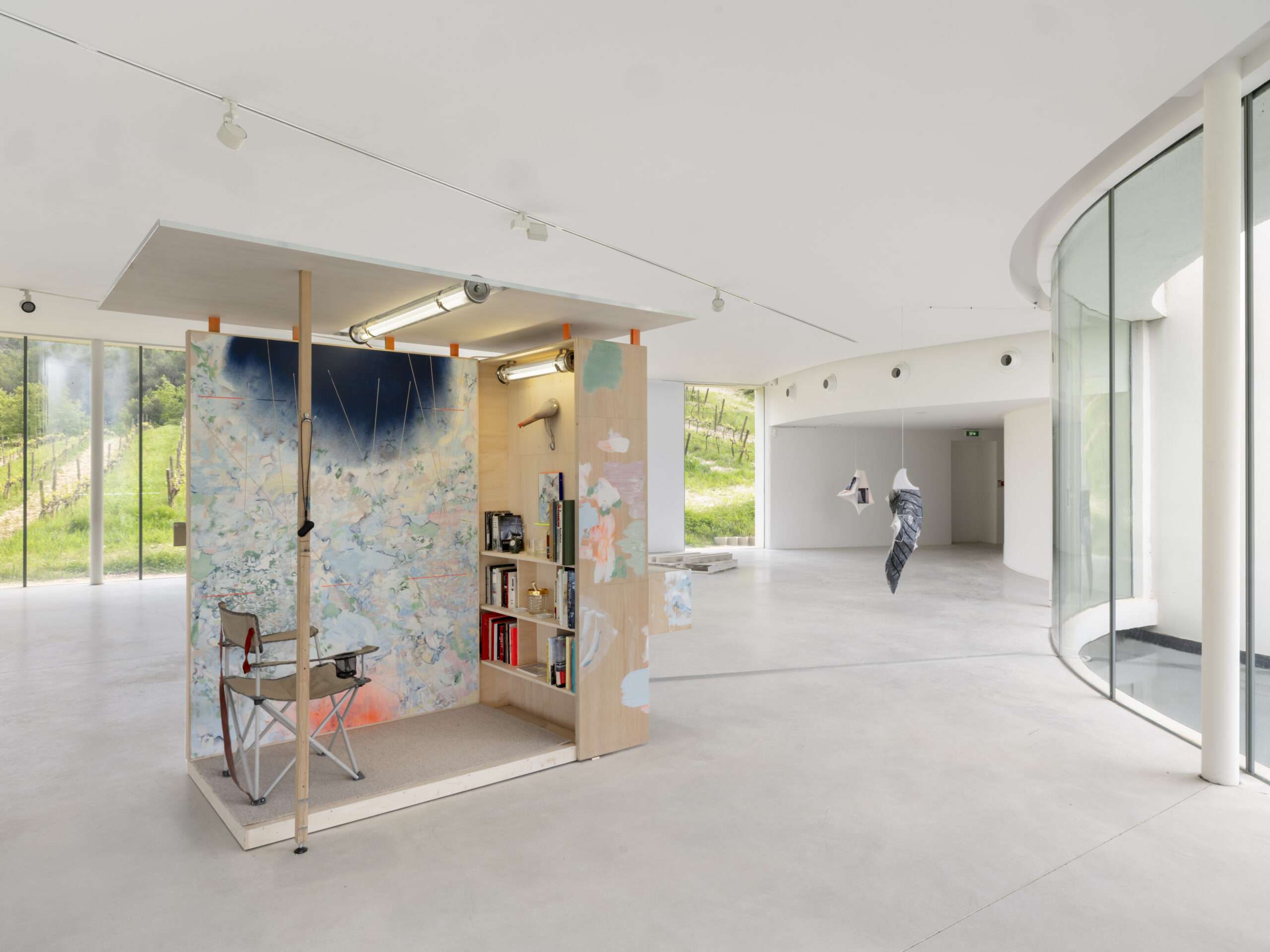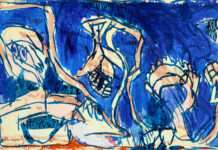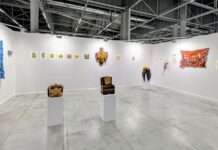
Hors-les-murs Poush x Château La Coste Exposition Par quatre chemins, Points de vue sur la scène actuelle, Crédit Martin Argyroglo
As POUSH prepares to turn the page on its chapter in Aubervilliers, home to more than 270 artists, representing over 30 nationalities, with 200 exhibitions across 22,000 square meters, its director Yvannoé Kruger reflects on what has made this bold experiment a benchmark in the contemporary art scene. What began as a daring initiative during the lockdown has evolved into a dynamic hybrid space, merging the roles of artist residency, incubator, and cultural hub.
At the heart of POUSH’s success lies a spirit of constant reinvention and intergenerational exchange (with the average artist aged between 35 and 40), a strong commitment to inclusivity in both artistic practices and backgrounds, and a raw, collective energy that has come to define the space. As Kruger notes, these elements have helped establish POUSH not only as a local model but as a reference point far beyond the borders of Paris and its suburbs.
While the Aubervilliers site nears its close, the road ahead remains ambitious. A new location is set to be announced shortly, and in the meantime, Kruger is curating a final exhibition on-site titled Minimal Minimal, offering one last reflection on the space’s journey. Simultaneously, the off-site exhibition Les Quatre Chemins, showcasing 35 artists at Château La Coste (Bouches-du-Rhône), remains on view. We spoke with Yvannoé Kruger about POUSH’s legacy, its evolution, and what’s next.
A curator trained at University of the Arts London — at both LCC and Central Saint Martins — Yvannoé Kruger is known for forging connections between different artistic disciplines, often bridging into science, gastronomy, and craftsmanship. After starting out in fiction and documentary filmmaking, he turned to curatorial work, joining Jean de Loisy’s artistic programming team at the Palais de Tokyo from 2011 to 2015. There, he organized numerous performances, festivals, concerts, and installations. Since 2020, Kruger has served as the director of POUSH — an internationally recognized space dedicated to supporting artistic creation, bringing together a contemporary art center and artists’ studios under one roof. Over the course of his career, he has curated more than thirty exhibitions.
Since the very beginning of the POUSH adventure in 2020: in your view, what explains its success and growing visibility?
POUSH’s success lies first and foremost in its unique story. We opened on the very first day of the COVID lockdown, in March 2020. It was a project born out of rupture — a moment when nothing was functioning normally, and artists were particularly vulnerable. POUSH became a kind of sanctuary, a refuge, but also a springboard for a new generation of artists.
We had just wrapped up our previous adventure at L’Orfèvrerie, where we had supported major artists like Neil Beloufa and Jean-Marie Appriou, who were already gaining significant attention. Then suddenly, we moved into an empty office tower in Clichy and transformed it into a space for creation — a place of total freedom and collective experimentation. That’s how POUSH was born, at the edge of Paris in the « Porte Pouchet » area, which is where the name comes from.
Very quickly, a strong sense of community took shape. We made workspaces available, set up an entire floor for exhibitions, and encouraged informal — and at times, admittedly semi-clandestine — gatherings. These moments allowed artists to connect, break the isolation of lockdown, exchange ideas, and grow together. At a time when everything was closed — galleries, museums, art centers — POUSH remained open. That made it one of the only places in Paris where you could still experience art, and that became a real catalyst.
What also helped the project gain momentum was our commitment to welcoming artists from beyond France. From the start, we opened our doors to international artists — many from Latin America, former Soviet countries, North Africa… Today, POUSH is home to nearly 40 nationalities, and close to 40% of our artists come from abroad. They are our greatest ambassadors, and thanks to them, POUSH quickly gained recognition far beyond the Paris art scene.
One key moment that really helped shape the project was the launch of the Journées Professionnelles. We invited art critics, curators, and journalists to meet artists in their studios. It wasn’t just an open house — we provided real curatorial support, organized exhibitions and performances, and guided each visitor based on their interests. Over time, these events grew to welcome a broader audience: other artists, students, collectors, and art enthusiasts.
Finally, POUSH has become a living space, constantly in motion — with a restaurant, a bar, regular events — but most importantly, an ability to reinvent itself. After Clichy, we opened a new site in Aubervilliers, inside a former factory — a return to something more raw — which welcomed a new wave of artists and offered the public an ever-evolving view of contemporary creation. I believe it’s this constant renewal, this openness to others and to life itself, that defines POUSH’s strength and singularity.
How do you select the resident artists at POUSH ?
Since POUSH was launched, we’ve issued three or four public calls for applications. Outside of those key moments, we occasionally fill vacant studios — though that happens quite rarely — by drawing from a long waiting list. From the beginning, our approach to selection has been about carefully building an ecosystem that reflects the richness of artistic practices and individual journeys.
We’ve always sought a certain balance: bringing together mid-career artists who already have significant recognition and come to POUSH to explore new directions, with younger artists — sometimes fresh out of art school — who are already making waves on the emerging scene. The average age of artists at POUSH is around 35 to 40 years old. So, it’s not a “young” space in the strict sense, but rather a truly intergenerational one. That coexistence of generations, energies, and narratives is a key part of what makes the place so dynamic.
Another crucial criterion is the desire to be part of a collective energy. Some highly established artists — including those represented by major international galleries — approach us. But if their only goal is to have a large, affordable studio without engaging with the life of the space, it doesn’t really align with our vision. What we’re looking for, above all, are artists with a genuine desire to exchange ideas, who contribute to the project’s collective intelligence, while still maintaining their own creative solitude.
We’ve also always paid close attention to first-time arrivals in France, especially those from vulnerable contexts. We’ve worked with organizations like Les Ateliers des artistes en exil, and supported artists from Ukraine, Russia, Ethiopia, and Iran as they’ve settled into life and work in France. It’s been a quiet effort, but an essential one.
Diversity of practices is another key focus. While POUSH has always attracted a strong community of painters — and we do have an exceptional painting scene with artists like Dhewadi Hadjab, Pol Taburet, Madeleine Roger-Lacan, Cécilia Granara, Julian Farade, and many others — we’ve also made a point of cultivating a wide range of media: a dance studio (Studio K), a floor dedicated to sound practices, ceramics workshops, a video art hub, digital artists, performers, a radio station, and the Bureau des Penseur·euses — a space for curators, theorists, and writers.
And finally, even though we ask for CVs and portfolios in the application process, we try not to rely solely on how an artist presents themselves. Some proposals are highly conceptual, others powerful but poorly packaged. We do real, in-depth work: if something sparks curiosity, we dig deeper, we ask questions, we consult other curators. The idea is to never settle for a polished letter or slick portfolio. It’s a meticulous process, but it allows us to welcome artists who might not make it through a more traditional selection.
What is the rental cost for artists? Has it increased over time?
At POUSH, artists pay a monthly fee calculated per square meter, ranging from €9 to €12 (excluding taxes), depending on the features of the space — whether it’s heated, naturally lit, easily accessible, etc. This rate remains significantly below market prices, especially for studios of this size in the greater Paris area.
But this fee offers much more than just square footage. It includes multi-level support: weekly production follow-up, administrative assistance with Delphine Toutain, and artistic guidance provided by myself and the programming team. Most recently, we’ve also launched a professional development program in collaboration with Heartline, helping artists structure their careers — learning how to present their work, build a strong portfolio, prepare for meetings, and more. The initiative has just begun, and early feedback has been very encouraging.
We did implement a slight rent increase when we moved to the new site in Aubervilliers. While we made every effort to maintain the same pricing as in Clichy, it quickly became clear that sustaining the financial balance was becoming difficult: the setup and operating costs at the new site were considerably higher. This moderate adjustment was well understood and accepted by the artists, and it allowed the project to continue operating on the same foundational model. For the past year and a half, support from our neighbor, le 19M, in Aubervilliers has also played a key role in sustaining this momentum.
POUSH, From raw energy to an ever-more ambitious Structure : Has your founding philosophy evolved?
POUSH was born in Clichy, driven by raw, spontaneous energy. The initial challenge was significant: transforming a space with no dedicated budget into a fully functioning exhibition center. Over time, it became much more than a venue for showing work — evolving into a regular artistic meeting point, and a space for talks, training sessions, and exchange, in line with a vision that remains in constant motion.
The move to Aubervilliers marked a new phase of expansion. It required rethinking the layout, grouping residents by practice affinities, and creating hubs dedicated to specific disciplines: sound art, dance, performance. Alongside this, we introduced a growing number of support services — administrative, financial, communications, production, and professional networking — designed to help artists develop their practices sustainably.
Our now-expanded team operates in a more structured way, while maintaining the agility that defines POUSH’s identity. Because as POUSH grows, our core mission remains unchanged: not to rush the process, not to replicate the model of major institutions and to preserve the essential freedom and creative unpredictability that mark moments of true construction. These fragile in-between spaces — these breathing and inventing zones — are at the heart of the POUSH adventure. Now more than ever, we’re committed to making them last.
POUSH at Château La Coste: a strategic turning point in the South
POUSH’s invitation to exhibit at Château La Coste marks a significant milestone in its artistic expansion beyond its physical walls. It follows the momentum of a first off-site collaboration with the Lambert Collection in Avignon — a partnership made possible through Hervé Digne, then chairman of the board at the Lambert Collection and now president of POUSH’s board.
Digne also played a key role in connecting POUSH with Paddy McKillen, the Irish billionaire and founder of Château La Coste — a renowned estate where wine and contemporary art intersect. He supported McKillen in bringing his ambitious cultural vision to life in France, paving the way for this new collaboration in the South, and offering POUSH a major platform to showcase the work of its artists.
In a venue known for exhibitions by international heavyweights like Damien Hirst, giving carte blanche to a new generation of emerging artists was a bold — yet fitting — move, aligned with the diverse audience that Château La Coste attracts. The exhibition, titled Par quatre chemins, received exceptional backing: full financial support for the project — a rare gesture in a field where such funding is the exception, not the rule.
POUSH’s ability to respond swiftly to this kind of opportunity was once again decisive. Thirty-five artists made the journey, accompanied by their gallerists, friends, and supporters, giving the opening the atmosphere of an art-world summer camp — warm, spontaneous, and full of camaraderie. Par quatre chemins ultimately became a joyful, living celebration of everything POUSH has stood for since its inception.
What upcoming projects are driving you right now?
We’re preparing for one final major exhibition, which I’m curating myself — something I’ve often delegated in recent years. While I recently proposed the show Obstiné.e.s, it was a short-term project designed to fill a scheduling gap.
Minima Minimal, which brings together 20 artists, will open on May 22. It’s not a revival — it’s a shift. To the question “What remains of minimalism today?”, the exhibition offers various attempts at answers and resolution. It’s a background noise we thought had faded, a strange echo, a way of being in the world. What’s being sought is no longer pure reduction, but a kind of focus — a means of making visible what would otherwise disappear in the noise of the world.
The exhibition, held at POUSH, aims to explore those tensions, those hesitations, those inflection points. Works made from salvaged materials will stand alongside precise, pared-down gestures, raw interventions, and installations where absence weighs as much as presence. Leading artists will be shown in dialogue with younger practices, crossing perspectives and geographies — affirming Paris as a place where these new forms are taking shape.



